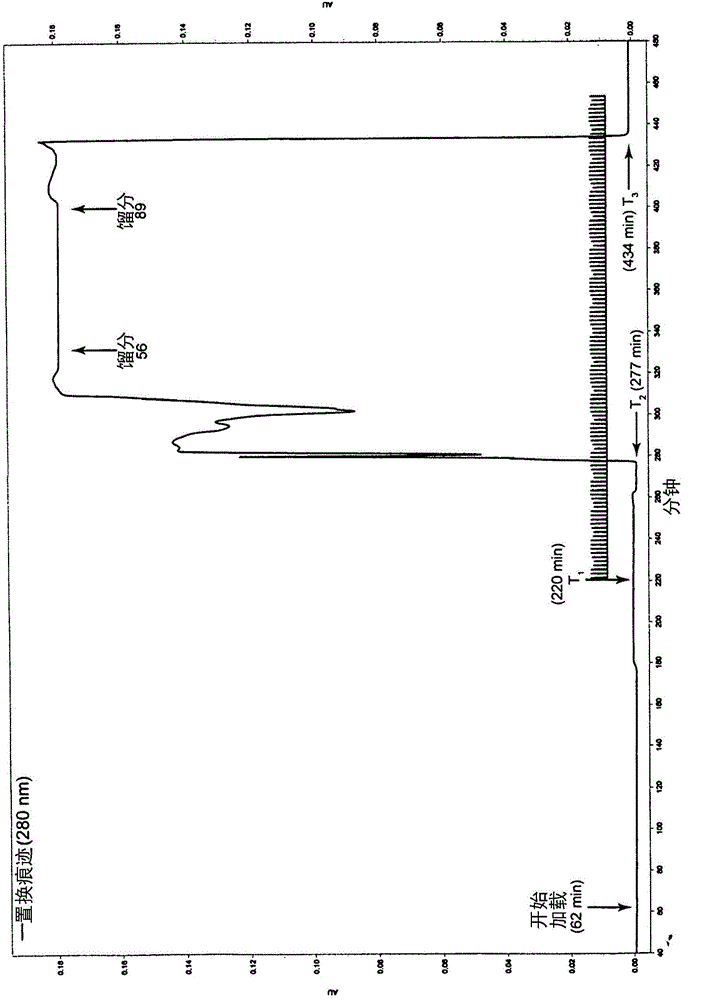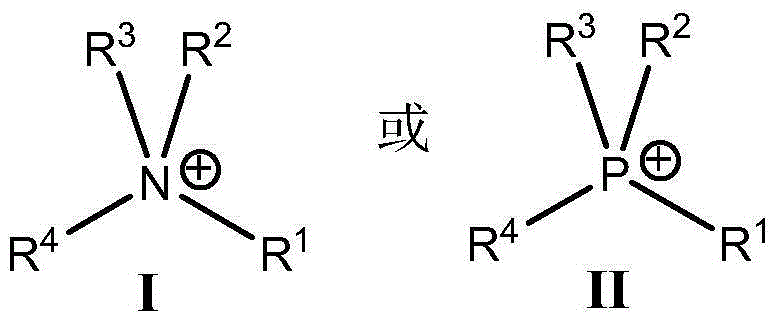Neutral Zwitterionic Displacer Molecules for Hydrophobic Displacement Chromatography
A displacement chromatography and zwitterion technology, which is applied in the field of neutral zwitterion displacer molecules for hydrophobic displacement chromatography, and can solve problems such as the inability of displacer compounds to work well
- Summary
- Abstract
- Description
- Claims
- Application Information
AI Technical Summary
Problems solved by technology
Method used
Image
Examples
Embodiment 2
[0224] (2) Select the initial concentration of the sample by one of two methods:
[0225] (a) Initial sample concentration (mg / mL) = 0.25x replacement agent concentration (mM) x formula weight (mg / μmole)
[0226] = 0.25 x 10 mM x 1.7466 mg / μmole = 4.37 mg / mL (for Example 2 below)
[0227] (b) Select an estimated column binding capacity for the sample, eg 50 mg sample / mL matrix. Assuming the displacement flow rate and the sample loading flow rate are the same:
[0228] Initial sample concentration (mg / mL) = (column binding capacity (mg / mL) m ) x column volume (mL m ) / ((T 2 -T 1 ) x sample flow rate (mL / min))
[0229] =(50mg / mL m x4.155mL m ) / ((434min-220min)x0.208mL / min)
[0230] =4.67mg / mL
[0231] (for Example 2 below)
[0232]If the first DC experiment with loaded samples resulted in an overloaded condition (>100% loading), the experiment was rerun at half the sample concentration. From the results of the first successful DC experiment using the sample, the actua...
Embodiment 1
[0260] Example 1: Displacement Protocol for Purification of Crude Synthetic α-Endorphin
[0261] Instrument configuration : Main pump (1) with 4 buffer lines, sample loading pump (2) with 1 solvent line, pump selector valve, column bypass valve (ColumnBypassValve)
[0262] Pump selector valve: 6-way valve controlled by single-channel toggle logic (S3=0, pump 1 to column-pump 2 to waste; S3=1, pump 1 to waste-pump 2 to column)
[0263] Column valve: 6-way valve, which is controlled by a single channel switching logic (S6 = 0, liquid flows through the column; S6 = 1, liquid flow bypasses the column)
[0264] A UV photodiode array detector (flow cell: 0.5 mm flow, 9 μL volume) after the column, followed by a conductivity detector (flow cell: 170 μL volume); the conductivity flow cell was removed when fractions were collected for analysis.
[0265] Loading buffer = A-line on pump 1 (S1 = 1 - flow on, S1 = 0 - flow off); Displacer buffer = B-line on pump 1 (S2 = 1 - flow on, S2 =...
Embodiment 3
[0295] Embodiment 3: HPLC analysis-
[0296] Method 3a, 3b - reversed phase for neutral zwitterions: using Waters996PDA detector and WatersXbridge BEH130 equipped in series with Dionex / ESABiosciences (Chelmsford, MA) CoronaPlusCAD detector and WatersXbridge BEH130, 5 μm, 4.6x250mmSS, -C on Silicone 18 , gradient HPLC on a reversed-phase column (Chelmsford, MA) from Waters (Milford, MA).
[0297] Sample injection: 25 μL of ~1 mM sample solution in A buffer
[0298] UV detection: 208-220nm, depending on the compound to be analyzed
[0299] Flow rate: 1.0 mL / min.
[0300] A buffer: 5% CH with 0.1% (v / v) trifluoroacetic acid 3 CN (v / v) in HPLC-grade distilled water.
[0301] B buffer: 5% H with 0.1% (v / v) trifluoroacetic acid 2 O(v / v) in HPLC-grade CH 3 CN.
[0302] Survey gradient method: 100% A0-2min
[0303] 100%A to 100%B2-62min
[0304] 100% B62-70min
[0305] Analytical gradient method:
[0306] Method 3c – reverse phase for long chain alkyl halides:
[0307]...
PUM
 Login to View More
Login to View More Abstract
Description
Claims
Application Information
 Login to View More
Login to View More - R&D
- Intellectual Property
- Life Sciences
- Materials
- Tech Scout
- Unparalleled Data Quality
- Higher Quality Content
- 60% Fewer Hallucinations
Browse by: Latest US Patents, China's latest patents, Technical Efficacy Thesaurus, Application Domain, Technology Topic, Popular Technical Reports.
© 2025 PatSnap. All rights reserved.Legal|Privacy policy|Modern Slavery Act Transparency Statement|Sitemap|About US| Contact US: help@patsnap.com



